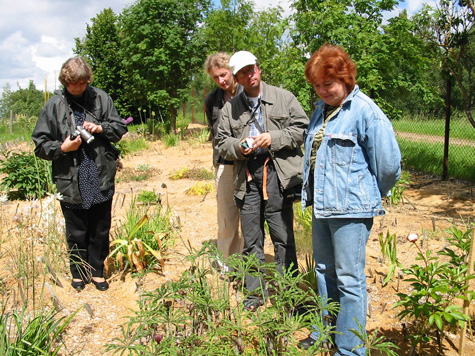Human Flower Project
Urmas Laansoo: Let’s Moss Crawl
Allen Bush introduces us to an Estonian plantsman who specializes in lichens and pillowcases. Thank you, Allen.

Hallan Kivisaar’s sculpture garden, Estonia
Photo: Allen Bush
By Allen Bush
I traveled to Austria and Italy with The Ratzeputz Gang in September 1991 to visit nurseries and gardens. My favorite memory is a leisurely luncheon on nurseryman Lorenzo Crescini’s hillside near Brescia (Italian plant hunting requires eight-course nourishment and Barbaresco wine). Before heading back to North Carolina, where I had my own nursery at the time, I left my horticultural running mates and flew to England, making a beeline to Cambridgeshire. It was dark by the time I arrived at Joe Sharman’s home – too dark to look around for new perennials at Sharman’s Monksilver Nursery, a few miles down the road.
It was dinnertime. Sharman’s’ business partner, Alan Leslie, was there. He works full-time as a botanist at the Royal Horticultural Society garden at Wisley in Surrey and comes-up on weekends to tend to nursery chores. Joe’s mother prepared a nice meal for a table of gardeners and guests. It felt like a tiny arena. Hundreds of books were stacked high like bleachers around the edges of the dimly lighted room. There was plenty of jostling Latin binomial nomenclature at ringside.
 Urmas Laansoo, lichen and pillowcase expert
Urmas Laansoo, lichen and pillowcase expert
Monksilver Nursery, Cottenham, Cambridge England 1991
Photo: Allen Bush
At the opposite end of the table was an unidentified man. I guessed he could be Sharman’s brother. No one introduced him; no one spoke to him – perhaps for familial good reason. I wasn’t sure. He didn’t say a word. Finally, late in the dinner, Alan Leslie presented the quiet one—a visitor from the Tallinn Botanic Garden. I’d never met anyone from Estonia. Urmas Laansoo surprised me and said he’d never met anyone from the United States. For better or worse, I had presumed that everyone had met an American.
(Ten years later, in 2001, a few days following September 11, I was in Pong Bu, a little western Sichuan village. Before then it had seldom occurred to me what the privilege and responsibility of being an American could mean. My plant collecting party surprised a school full of young Tibetan kids who crowded around, staring at odd people they had never seen before. I worried hairy Caucasian arms would be my legacy. These sweet children followed us part way up the mountainside – bright-eyed and curious – unaware of what was going on in the next village, much less the other side of the world.)
The Russians kept a stranglehold on Estonia for nearly fifty years, but the empire collapsed in August 1991 and Estonia declared its independence. Estonians were free to travel. Urmas had high-tailed it to England. He wanted a glimpse of what was going on in the gardening world. The Royal Botanic Gardens at Kew overwhelmed him. It was “like heaven, just fabulous … we had empty shops at home and food-shortages…you were allowed to buy sugar and milk, soap and matches in a very limited way…I felt too full of plants, visiting Kew Gardens, just too much of new plants for the first time visit!”
Urmas and I chatted a bit that evening and picked-up the conversation the next day while wandering around Monksilver’s fascinating collection of rare perennials. We’ve kept in touch since. I look forward to his holiday greetings.
At this time of year, his countryside is dark and usually snow covered. Mine is gray and sodden. It’s a good time for Urmas to get away, and the Indian Ocean has its appeal. Here and only here is his favorite tree: Mathurina penduliflora, endemic to the Mascarene archipelago. Urmas explains, “There are only 30 individuals left. It’s critically endangered in the wild. It grows only on Rodrigues Island in Indian Ocean. We have named this tree in Estonian language as “Tree of Cheerful Tears”! As I met the tree the first time on Mauritius Garden of Pamplemousses (Sir Seewoosagur Ramgoolam Botanical Garden), I started to cry, it was so beautiful and unique! And still is!”

Staff of the Tallinn Botanic Garden – (from left) Mari Seidelberg, Krista Kaur, Urmas Laansoo, Taimi Puusepp – in the garden of plant Estonian collector, Sulev Savisaar. In front is the rare Chinese Jack-in-the Pulpit, Arisaema ciliatum var. liubanense
Photo: Siiri Liiv
Urmas started work at the Tallinn Botanic Gardens as a schoolboy in 1978 but traces his gardening roots to February 1966, in the village of Kohila. He was the tender age of four. With the nudge of his grandfather, he started cucumber seeds, on a windowsill. He still lives – and gardens – at the same childhood home. Today Urmas is a botanist on the education staff at the Tallinn Botanic Gardens, author of books, and television presenter of nature programs, leading excursions in Estonian, Russian, Finnish, and English. There’s no hint that he is ever bored.
In late May 2003 I made a two-day visit to see Urmas with Ratzeputzers Klaus Jelitto and Steve Still. After a few days in St. Petersburg, Russia, we arrived in Tallinn after a day-long bus ride driving past small towns and birch forests carpeted with ferns. (Air travel between the two cities wasn’t possible due to a lingering political feud between the two countries.) From occasional communications over the previous eight years, I supposed that Laansoo was probably a pretty competent plantsman, but I had no idea what to expect. Plantspeople can be peculiarly one-dimensional and sometimes as obsessive – and boring—as stamp collectors. Rare in this breed is the outlier who can keep a couple of balls in the air at once. Normalcy and obsession are at odds. Urmas is interested in history, music and literature and is thoroughly entertaining – and normal.
 Hallan Kivisaar’s sculpture garden, Estonia: ideal for a moss crawl
Hallan Kivisaar’s sculpture garden, Estonia: ideal for a moss crawl
Photo: Allen Bush
We crawled around in these woods looking at mosses and lichens.Urmas showed us the impressive collections at the Botanic Garden. There were particularly large accessions of Peonies and Iris. And Phlox species and cultivars were on his radar screen for new acquisitions. But Urmas, though crazy about plants, skipped the chest-thumping so common among collectors. He’s as modest as he is brilliant. The rock garden included some alpine gems that he had been able to collect in the Pamirs of Tajikistan, near the Afghanistan border, and Tian Shans in Kazakhstan. The glass houses and Palm House are filled with tender species – some from collecting trips to Tenerife, Gran Canaria and La Gomera islands.
For bragging rights plantspeople will talk sometimes about how many rare things of this and that they’ve got tucked away. (Urmas doesn’t brag about plants but mentions he collects pillow cases and Christmas lights.) Some of the more interesting gardening characters have a working knowledge of the native species that grow in nearby woods and meadows. Precious few know much about mosses and lichens.
And endangered, I’m afraid, is the gifted natural educator, like Urmas, who can get you on your hands and knees crawling around in the woods looking at mosses and lichens as he spins a dazzling botanic yarn that makes your head revolve. You feel like an idiot when you get-up; you don’t know diddly. But your senses have been jolted, because you never imagined “this-is-fun” value in lower life forms.
Urmas also gave us a peek at a Baltic Bronze Age cemetery, and we visited a few very interesting local nurseries and gardens. I wouldn’t know a Benjamin Franklin Z Grill postage stamp if I saw one. But thanks to Urmas I know a little about mosses and lichens. Hang around long enough and I might get a bug for pillow cases and Christmas lights.


I have a passion for pillow cases!
Great story Allen. I look forward to more recollections of your travels.